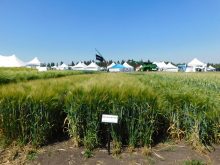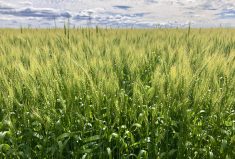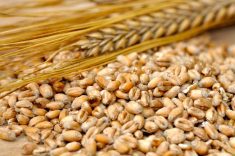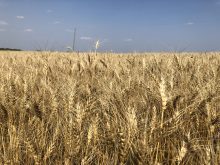Kevin Sich thinks malt barley could give canola a run for its money any day of the week — even if market share doesn’t reflect that.
“Malt barley is probably one of your most profitable crops. Return on investment is probably very strong,” said Sich, Rahr Malting’s grain department manager.
“But if malt barley is that profitable, why isn’t there 20 million acres of it grown like there is for canola?”
The answer is pretty straightforward: “It’s a speciality crop with limited market access.”
Read Also

New crop insurer policy enables easier startup for faba beans
Agriculture Financial Services Corporation updated its normals for faba beans, which may open the door for more Canadian producers to feel comfortable growing the pulse crop in the future.
“You’ll hear it in the coffee shop — ‘I had great malt barley, but I couldn’t find a market. I’ve got bins full of it. I’m going to have to sell it for the cows,’” Sich said at the Cereals Innovation Symposium last month.
But that doesn’t tell the whole story. About 80 per cent of the malt sold comes from about 20 per cent of barley growers in Western Canada, he said.
- Read more: Malting barley production down, quality up
“If you’re one of the guys right now who’s in that 20 per cent, you’ve got it figured out. It’s the other 80 per cent of the barley growers fighting for 20 per cent of the market.”
And that fight is a tough one. Prairie farmers harvest about seven million tonnes of barley every year, and roughly 60 per cent of the seeded acres go to malt varieties.
That means a lot of hopes of cashing in on higher malt prices get dashed.
And even on the feed side, things are getting tougher because the export market is getting more competitive. The two big customers are Saudi Arabia (about 10 million tonnes of feed annually) and China (about 7.3 million tonnes of both feed and malt).
“Canada is trading into both, but a lot of the feed markets are now being serviced by the Black Sea region,” said Sich. “If you grow malt and end up with feed, your export opportunities are limited.”
But what about the craft beer craze? Isn’t that pumping up demand for malt?
Sorry, but not really, said Sich.
“For every 12-pack you drink of your local craft suds, it means you’re probably not buying a 12-pack of the big-box store beer. You’re seeing a net gain in malt usage, but not as much as everybody thought.”
Location and variety
So is there a way to get into that elite 20 per cent who capture the lion’s share of malt sales?
Yes and no, said Sich.
First, you have to be in the right place.
“Malt barley is like real estate — it’s all about location, location, location,” he said. “If you’re a barley grower an hour from the plant at Alix (a half-hour drive east of Red Deer), you should probably be growing malt barley, compared to somebody five hours away.
“If I can buy the barley from my guy an hour away at $200 a tonne, and I have to pay $220 farther out, it’s business.”
After that though, what you do on the farm makes a difference.
Start by picking the right variety.
“When you go out into the field in the spring with a seed drill full of barley, you have a 50-50 chance of getting malt barley at that point,” said Sich. “But if you don’t start out with the right variety for the market you’re going after, you’ve already swung the odds toward the house by 80 per cent. You’ve got to start out with the right variety.”
AC Metcalfe has been the top choice but what Sich described as its “slow demise” began last year.
Copeland is an established alternative that’s gaining ground and AAC Synergy is also gaining ground.
“AAC Synergy seems to have a nice blend for the craft industry,” said Sich.
Yield and protein
It’s at this point that a grower’s skill comes into play.
The usual agronomic practices all matter save one — nitrogen application. And the advice here is to curb your instinct to go for as much yield as possible.
It’s a tricky equation, said Breanne Tidemann, a researcher at Agriculture Canada’s Lacombe station who recently co-authored a paper on how nitrogen (and preceding crops) affects protein levels.
Many would-be malt growers have a “nitrogen conflict,” she said.
“A producer’s goal is to increase yield so they can make more money, and nitrogen tends to be a surefire way to increase that yield,” said Tidemann. “But nitrogen also increases protein, which lowers your chance of making malt quality and, in turn, lowers your price premium. There’s a bit of a catch-22 around the use of nitrogen.”
How much nitrogen is too much?
In federal trials across the Prairies, researchers applied four different nitrogen rates (from zero to 100 kilograms per hectare) to five different varieties — AC Metcalfe, AAC Synergy, CDC Kindersley, ABI Voyager, and Cerveza. The goal was to see which rates pushed protein levels over the 12.5 per cent threshold typically recommended for malt.
Not surprisingly, more nitrogen boosted yields.
“Metcalfe was our lowest-yielding variety across all of our nitrogen rates. Our highest-yielding variety was AC Synergy regardless of nitrogen rate, followed by Voyager and Cerveza.”
And protein content?
“In this study, we were able to stay below that 12.5 per cent threshold with Synergy and with Voyager, even at our highest nitrogen rate,” said Tidemann. “Voyager had the lowest protein of our varieties. But Synergy stayed fairly low as well, with Kindersley and Metcalfe within the higher protein levels.”
She cautioned that these results were averaged across all site years, and in some years, even Synergy and Voyager went over the 12.5 per cent mark.
“We’re not guaranteeing that you can put on 100 kilograms per hectare of nitrogen and you’ll be below the 12.5 per cent threshold. But some of these newer varieties — like Synergy and Voyager — will allow for higher nitrogen applications, with an increase in yield, while maintaining acceptable protein levels.”















